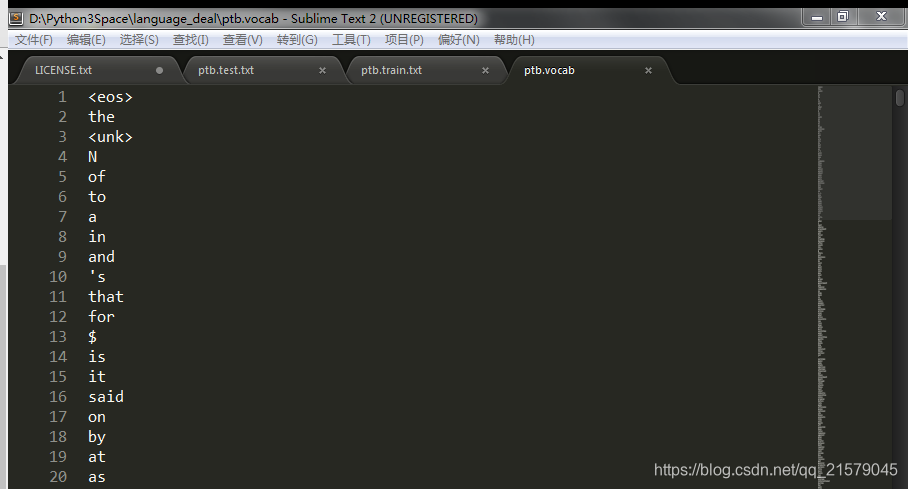参考书
《TensorFlow:实战Google深度学习框架》(第2版)
首先按照词频顺序为每个词汇分配一个编号,然后将词汇表保存到一个独立的vocab文件中。
#!/usr/bin/env python # -*- coding: UTF-8 -*- # coding=utf-8 """ @author: Li Tian @contact: 694317828@qq.com @software: pycharm @file: word_deal1.py @time: 2019/2/20 10:42 @desc: 首先按照词频顺序为每个词汇分配一个编号,然后将词汇表保存到一个独立的vocab文件中。 """ import codecs import collections from operator import itemgetter # 训练集数据文件 RAW_DATA = "./simple-examples/data/ptb.train.txt" # 输出的词汇表文件 VOCAB_OUTPUT = "ptb.vocab" # 统计单词出现的频率 counter = collections.Counter() with codecs.open(RAW_DATA, "r", "utf-8") as f: for line in f: for word in line.strip().split(): counter[word] += 1 # 按照词频顺序对单词进行排序 sorted_word_to_cnt = sorted(counter.items(), key=itemgetter(1), reverse=True) sorted_words = [x[0] for x in sorted_word_to_cnt] # 稍后我们需要在文本换行处加入句子结束符“<eos>”,这里预先将其加入词汇表。 sorted_words = ["<eos>"] + sorted_words # 在后面处理机器翻译数据时,出了"<eos>",还需要将"<unk>"和句子起始符"<sos>"加入 # 词汇表,并从词汇表中删除低频词汇。在PTB数据中,因为输入数据已经将低频词汇替换成了 # "<unk>",因此不需要这一步骤。 # sorted_words = ["<unk>", "<sos>", "<eos>"] + sorted_words # if len(sorted_words) > 10000: # sorted_words = sorted_words[:10000] with codecs.open(VOCAB_OUTPUT, 'w', 'utf-8') as file_output: for word in sorted_words: file_output.write(word + " ")
运行结果:


在确定了词汇表之后,再将训练文件、测试文件等都根据词汇文件转化为单词编号。每个单词的编号就是它在词汇文件中的行号。
#!/usr/bin/env python # -*- coding: UTF-8 -*- # coding=utf-8 """ @author: Li Tian @contact: 694317828@qq.com @software: pycharm @file: word_deal2.py @time: 2019/2/20 11:10 @desc: 在确定了词汇表之后,再将训练文件、测试文件等都根据词汇文件转化为单词编号。每个单词的编号就是它在词汇文件中的行号。 """ import codecs import sys # 原始的训练集数据文件 RAW_DATA = "./simple-examples/data/ptb.train.txt" # 上面生成的词汇表文件 VOCAB = "ptb.vocab" # 将单词替换成为单词编号后的输出文件 OUTPUT_DATA = "ptb.train" # 读取词汇表,并建立词汇到单词编号的映射。 with codecs.open(VOCAB, "r", "utf-8") as f_vocab: vocab = [w.strip() for w in f_vocab.readlines()] word_to_id = {k: v for (k, v) in zip(vocab, range(len(vocab)))} # 如果出现了被删除的低频词,则替换为"<unk>"。 def get_id(word): return word_to_id[word] if word in word_to_id else word_to_id["<unk"] fin = codecs.open(RAW_DATA, "r", "utf-8") fout = codecs.open(OUTPUT_DATA, 'w', 'utf-8') for line in fin: # 读取单词并添加<eos>结束符 words = line.strip().split() + ["<eos>"] # 将每个单词替换为词汇表中的编号 out_line = ' '.join([str(get_id(w)) for w in words]) + ' ' fout.write(out_line) fin.close() fout.close()
运行结果:
